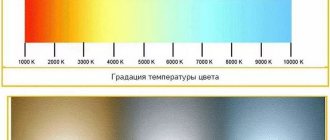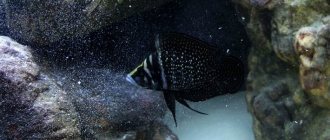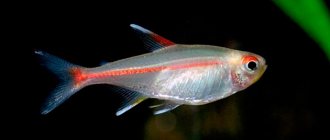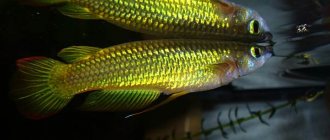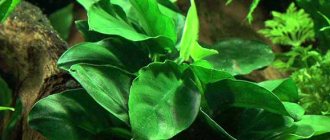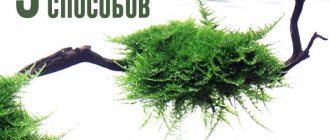Anubias nana is a plant suitable for beginner aquarists. Anubias differs from other aquarium plants in its ease of maintenance and unpretentiousness. Its other name is Dwarf, the species received due to its slow growth. This fact makes Anubias even more suitable for beginners because it does not require constant pruning and shaping.
Its habitat in the wild is the tropics in Africa.
Description
Anubias nana is a subspecies of Anubias Barter that can grow in water and on land. A. Enger was the first to describe Anubis. This is a low plant, no more than 16 cm long, with a structure in the form of a small bush. It does not grow in height, but it is capable of covering the entire bottom of the aquarium. The leaves are singly attached to short and fragile stems and have an oval shape. In the plant, their size is about 5 cm. Large leaves form a dense layer of greenery, the appearance of which especially stands out on the ground or driftwood. The roots are powerful, but do not go too deep into the ground, but spread out to the sides. The plant is distinguished by its endurance to changing environmental conditions, as well as stress resistance.
In nature, the plant lives in the shady part of reservoirs with weak or no current: swampy places, streams, rivers, lakes.
Structure and appearance of the plant
Anubias nana rarely pleases with flowers, especially in an aquarium.
The size of Anubias is small, the maximum height rarely reaches 10-12 cm. It has characteristic leaves - dense, oval, small, bright green.
In some varieties you can find long and lighter ones, in others - thickened and short, but in the description they are always rounded at the stem and pointed towards the end.
The plant is creeping, covering the bottom of the aquarium, branching its roots. Under favorable conditions, it quickly covers the bottom, growing not only with the root system, but also with leaves. It rarely blooms in water, but in greenhouses it pleases with white flowers . If the inflorescence appears in an aquarium, then after a week it withers and does not produce seeds.
Kinds
This family includes many species of Anubias:
- Aftzeli or Aftzelius.
- Dwarf or nana.
- Congolese or carved-leaved.
- Graceful.
- Bartera nana.
- Bartera variegated.
- Nana is petulant.
- Nana golden or golden.
- Bonsai.
- Nangi.
Let us describe the most common species among aquarists.
Dwarf
It grows along bodies of water and is usually completely in the water, often taking root in the roots and trunks of trees or among stones. It was first discovered in the tropics of Cameroon. The height of the plant does not exceed 15 cm. The plant is bushy with short petioles, on which there are 1 leaf measuring 5 cm. The root system is powerful and branched. The tough leaves prevent fish and other creatures from eating them.
Diseases and pests
The skin on the surface of the leaves protects Anubias not only from being eaten by fish, but also from pests. Only small algae can settle on them .
From muddy water, the pores become clogged with debris, and the entire leaf blade slowly dies.
Direct sunlight causes brown spots on the plant. At water temperatures below 23 °C, Anubias stops its development and may not resume.
The beautiful and unpretentious Anubias Nana will become a real decoration of any aquarium and will not cause much trouble to the owner.
Maintenance and care in the aquarium
With proper care in the aquarium, Nana grows quickly and looks healthy.
Tolerates changes in environment well without an adaptation period.
Aquarium dimensions
The look adapts to any volume and shape. It is planted in nanoaquariums and in tanks of several hundred liters.
Water parameters
Anubias nana prefers water with very low hardness; it will not die in hard water, but will stop development and growth. Almost any acidity is suitable, but it is better not to exceed 6–9 pH.
The plant survives temperature fluctuations from 18 to 35 degrees. But if possible, maintain a comfortable temperature for the nano at 23–26 degrees.
Lighting
Both in nature and in the aquarium, Anubias nana prefers shaded areas, but it also feels good in diffused light. The light produced by incandescent lamps is poorly tolerated due to its excessive brightness.
Advantages and disadvantages
Anubias nana has a lot of advantages:
- It is easy to care for; the plant does not need to be fed often. And when kept with fish, special fertilizers are not required at all.
- The choice of fish to keep together is unlimited.
- Due to its small size, it does not require much space; it allows you to create even a mini-aquarium.
- Combines with other plants.
- Easily propagated vegetatively.
Several disadvantages may hinder the breeding of Anubias nana:
- Slow growth.
- In stores they will ask a rather high price for a plant.
- Normal lighting has a bad effect on the growth of Anubias: blue-green algae can take a liking to its surface.
- If filtration is poor, the leaves die.
- Does not bloom under water.
Compatibility with fish
The Nana plant is compatible with almost all types of fish due to its adaptability to different conditions. Its leaves are too tough to be damaged by herbivorous inhabitants.
View this post on Instagram
Posted by Oksana Tissen (@oksana_tissen) May 7, 2021 at 9:58 am PDT
They are incompatible with fish that love bright direct light or with fish that are too cold-loving.
Compatible:
- Catfish.
- Pecilia.
- Guppy.
- Neons.
- Discus.
- Snails.
- Shrimps.
- Cichlids.
Weakly compatible:
- Goldfish.
- Congo blue.
- Lyalius.
Reproduction of dwarf Anubias
Anubias is propagated by separating fragments of the rhizome - vegetatively. Signs of readiness for reproduction are the appearance of shoots with leaves on the roots or the presence of buds.
Once the sucker has formed its root system, it is ready to be separated from the adult plant (sometimes this occurs without intervention).
The plant can also reproduce by seeds - but this occurs after flowering has ended, and this is only possible in the air. In nature, after flowering, the seeds fall off and then germinate in the ground, so there are many daughter plants around an adult Anubias.
Bookmarks 0
Photo gallery
Decorative properties
Anubias nana is valued by aquarists for its spectacular appearance. The plant is excellent for decorating aquariums, the surface and bottom of a reservoir. Slow growth, grace and miniature size allow the plant to be used to create designs in containers of any size.
It can be planted both in the background and foreground, as well as in the central part of the aquarium. Alternating the plant with other aquarium crops, taller and larger, creates the illusion of an underwater tropical forest, which looks simply enchanting.
How to distinguish between Anubias nana petit and bonsai
Based on the wild species, breeders have developed several ornamental varieties, one of which is called Anubias barteri var. nana Bonsai or just bonsai. It differs from the original species in having sparse leaves (up to 2.5 cm in length and up to 1.5 cm in width), as well as much lower bushes, the height of which does not exceed 4 cm.
This variety looks very attractive, it can decorate any aquarium, but it is especially loved by owners of so-called nanoaquariums, the volume of which is only 10–15 liters.
The variety Anubias barteri var. is extremely similar to bonsai. nana Petite, most often called simply petite. It was bred by Singaporean breeders. Actually, it has practically no differences from bonsai, except that it is a little taller - it reaches 5 cm in height.
Decorating an aquarium with anubias
You can see Anubias in the aquariums of beginners and professionals. These plants are unpretentious in maintenance and hardy. For their growth, you don’t need to bother with lighting, supply of carbon dioxide and fertilizers. And with all this, they look very beautiful. Professionals often have several different types of Anubias growing in their aquariums. Thanks to its slow growth, there is no need to weed every few weeks. They can be used to green up aquariums in which goldfish and cichlids live. Plants can be planted in the ground, leaving the rhizome unburied. Or you can tie it to a pebble or driftwood and rearrange the aquarium at least every week.
Main lighting requirements
Anubias nana does not belong to the category of light-loving aquarium crops. In the summer, natural sunlight will be sufficient for the plant to fully develop. In winter and autumn, weak fluorescent light bulbs can be used for these purposes.
With excessively intense additional lighting, Anubias can be affected by parasitic algae. In addition, when using artificial lighting, it is important to ensure that its sources are not located too close and do not leave burns on delicate, sensitive leaves.
Therefore, in bright light, it is recommended to place the plant in shaded areas of the aquarium. The recommended length of daylight for Anubias is approximately 10 hours throughout the day.
Recommended fertilizers
To prevent the development of the disease or death, experts recommend using fertilizers and fertilizers:
- Iron chelate: has a good effect on the density of the carpet, replenishes the lack of vitamin D;
- nitrogen-containing fertilizers: when there is a lack of nitrogen, leaves fall off;
- potassium-containing fertilizers: potassium protects leaves from rusting;
- a mixture of boron and calcium: enhances and accelerates growth.
Anubias is a beautiful, unpretentious, ornamental aquarium plant that, with proper care, can grow without causing any problems. If you decide to buy a plant for your home aquarium, carefully inspect the leaves before purchasing: they should be dense and fit well together. Touch the water in which the Anubias plants stood - the water should not be cold. Carefully inspect the rhizome: there should be no traces of rot or mucus on it.
Experts recommend the aquarium plant Anubias to beginning aquarists. The dense leaves are quite hard, so Anubias will not become a victim of herbivorous fish.
Reproduction and growing methods
It is worth noting that this is a rather labor-intensive and time-consuming process. It is connected, first of all, with the fact that this plant, in principle, grows quite slowly, and the aquarist should be mentally prepared for the fact that the result will not come immediately.
The easiest way is not to focus on growth at all. It is enough to carry out the necessary procedures and be distracted by other plants. You can propagate Anubias in the following way:
- Root division . For this plant, the separation of the rhizome will not cause significant damage. It is enough to tear off one piece and plant it in a good layer of nutritious substrate;
- Cuttings . The simplest and most popular method. To do this, the stem of the bush should be broken. The growth rate of the mother plant and the shoot will decrease significantly, but after a couple of weeks new cuttings will appear at the site of the break. It is better not to touch them at first. They will feed from the mother bush and later will finally become stronger in order to grow on their own;
- Picking . For this method, you need to select the strongest bushes and purchase seedlings. The roots are firmly and deeply immersed in the substrate to avoid floating.
The emerging shoots can be rooted in two ways. The first is to simply plant the “baby” in the ground, but it must have at least 5 leaves. The second is to take a large leaf and tape it to a sponge soaked in peat.
Also, the growth rate depends on where and how the anubias is planted. Therefore, it is advisable to select fine soil for it. This can be sand, small pebbles or a mixture of nutrient substrate. The main thing is that it is not large, and then the roots will be able to penetrate into the soil without obstacles.
However, soil is not at all necessary for this type of underwater flora. Its roots can feed simply in water. To do this, Anubias can simply be tied to a piece of driftwood. It must first be prepared so that it does not float and release harmful substances. When the snag is ready, you can start planting the anubias. This can be done using thread, fishing line (only carefully) or wire (with rubber protection). The plant is carefully wrapped so that it does not float up after a couple of days.
We recommend reading the article: How to prepare driftwood for an aquarium?
An example of planting Anubias on driftwood.
It is advisable to choose those sections of driftwood that will be located in the lower water column of the aquarium. As mentioned above, Anubias love shade, and if they are located high and the lighting is bright, the plant will simply die. If the light is diffuse and weak, then the location does not matter.
After a certain period of time, the fishing line or wire can be removed. But first you should make sure that the bush has taken root well and that it has firmly grasped the branch.
Actually, growing in an aquarium is no different. But this process is much more interesting to carry out in a paludarium or greenhouse, since in nature Anubias grow on land, and only their roots are in the water.
Most species easily get used to air. Therefore, it is enough to choose the mature bushes you like, and then transfer them to a paludarium or greenhouse. The main condition for growth is the presence of humidity and high temperature, 25-30 degrees.
Planting bushes in a paludarium directly depends on the water level. Therefore, in order for the bush to take root, it is necessary to prepare the place where it will be planted. If the level is high enough and it is not possible to plant the plant on the bottom (so that the leaves will subsequently be in the air), then you can use the same stones (pebbles, basalt, quartz) or driftwood (fruit rocks).
Alternatively, you can use regular pots for indoor flowers. If you don’t want them to be conspicuous, then it’s better to put mosses on them. They will quickly cover the pot. It is important that its edge is flush with the surface. This will allow you to plant the Anubias so that the roots are in the water and the leaves are on dry land.
As for the soil for the paludarium, small pebbles or nutrient mixtures are suitable. Alternatively, you can spread a thin layer of soil and cover it with soil on top. The bush itself needs to be planted so that its roots are directly in the ground. This will ensure high-quality nutrition and high humidity levels (in the greenhouse).
How to plant correctly
The ideal soil for Anubias nana is nutritious, silty soil. You can use purified river sand for these purposes, as well as peat and clay impurities and pebbles.
In order for the plant to take root well and develop fully, its rhizome should not be immersed in the soil too deeply. It is also forbidden to dig deep into the roots of Anubias, as this can lead to the death of the plant. It will be very good if you manage to place the culture on pitfalls and snags.
Watch the video about Anubias:
Conclusion
Any variety of Anubias requires warm water, shaded conditions, high humidity, regular water changes and filtration. Many of the species require nutritious soil.
Reproduction occurs by dividing the root system, cuttings and picking. The plant is not affected by pests, but it can suffer from anatactosis, form holes on the leaves and suffer from rotting processes at the growing point. Anubias Nana and Lanceolate are ideal for beginner aquarists.
10% DISCOUNT FOR BUYERS FROM REGIONS OF RUSSIA AND CIS COUNTRIES FOR AQUARIUMS, FISH, PLANTS, ETC.



